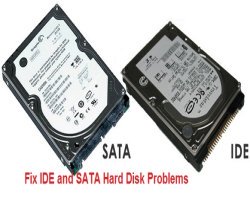Hard Disk Problems
Hard disk problems resolving guide. With the advancement of technology, computer use has rapidly increased and almost everyone is working using a computer machine. These machines are being modernized on a regular basis ensuring that they become more productive and easier to use.
Most of the old systems were developed using IDE drives and as the technology advances things have rapidly changed with the modern ones being developed using SATA drives. These two drives have different connectors which are meant for both data and power which makes it impossible to hook the wrong drive to an interface which is not meant for it.
How to Fix IDE and SATA Hard Disk Problems
The SATA drives have wider power cables than those of the data cables and on the IDE drives the power cable is the old fashioned Molex which has yellow, black and red wires while the data cable is just a wide ribbon cable. This makes it easy to distinguish between the two drives when installation is taking place.

The SATA drives have also been improved when it comes to the interface speed though replacing the previous SATA hard drive with the new one might be a bit difficult which might end up causing hard disk problems.
SATA drive does not boot Most of the time when the SATA drive does not boot reliably it is either because it is not recognized by the computer's BIOS or because it is not compatible with the controller.
If this happens you should check wither the drive has a compatibility jumper that is onboard which might force it to work appropriately. If the drive powers up however, this might mean that the data cable that is being used is either bad or it is not fitted properly on the motherboard or on the drive.
When it comes to the part when two IDE drives are sharing a particular cable then it is necessary for the computer system to have a way of differentiating them. This is usually done using jumpers on the two drives by setting one to Slave and the other one to Master.
Hard drive troubleshooting usually does not require much especially if you know how to differentiate between the different jumpers. The SATA motherboards come already fitted with the primary and the secondary IDE interface and this means that it is not necessary to use the two drive system on this cable. Here the boot drive has to be the Master on the interface of the primary IDE and if there is any other IDE drive that needs to share the same cable then it has to be on Slave.
See Also...




